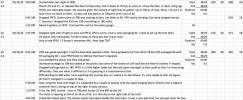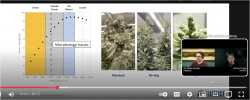So, I guess I'm a bit nervous to drive them harder, but yes, more light is the idea. So, I guess 1000 umol is the level they should be at then?
"I guess I'm a bit nervous to drive them harder" - you're
not "driving them" (but that is common perspective) you're
feeding them.
Light is how a plant makes food via photosynthesis and, in general terms, the more the merrier.
As long as light is the limiting factor, a cannabis plant will thrive at "800 to 1000"µmol. I put that in quotes because that's been the conventional wisdom for a few years but, even in the past year or so, more researchers are publishing their findings that cannabis will grow at over 1k. I've been running 1000+ for a couple of years now.
Should your grow be at 1k? You will tend to get a larger crop at 1k than at 700 and, it will be a little under 25% larger than it would be at 700µmol. That's based on the table below that I created from cited the paper (attached)
How can you get there? There is no need to increase light levels in small increments because your plants have already reached maturity in terms of their ability to take in light for photosynthesis. Having said that, I wouldn't just go from 700 to 1k overnight but there's no reason to not jump from 700 to 800 or 850 and then another jump.
A light meter will tell you (roughly) how much light is falling on the plant but only the plant will tell you how much light it can use. Fortunately, it's really easy to tell.
Here's how I would do it. Bump the PPFD by 150µmol at the start of the photoperiod and walk away from the tent. Thirty minutes after you increase PPFD, go back to the tent and check the leaves that are closest to the light.
If the light level is too high, cannabis will react by rolling up the sides of the leaf ("tacoing" or "canoeing") or by rotating the leaf around the petiole, in the same way that a Ventian blind opens and closes. If you see that happening or if there's some other unexpected change in the plants attitude, raise the light 1" or drop the dimmer input % by a bit. I would expect that you won't see that reaction.
That's the 30 minute check. If everything's OK, go away for another 30 minutes and check the plants again. Same rules as before—if something looks off, drop back a bit.
That approach is a good guideline for a maturing plant. Given the age of your plants (45± days?) you should be good to go but, if not, it's simply not an issue.
I checked through my grow journals the other day and it's common for me to give my plants too much light right at the three week mark. Below is copy/paste from my most recent grow journal.
DLI is in the rightmost column, PPFD is next to that. I checked for photos of the affected area and I don't have any—it's just such a non-event.


The screenshot below is from this video where Shane at Migro is the interviewer.
It was interesting to see what Fluence has found with inter canopy lighting but, in terms of light levels, what Hawley observed is that there was an inflection point at 1500µmol but they found that when plants were grown at very high light levels (>1100) , they ran into morphology issues.
Not all cultivars will respond to light in the same way. Apparently there are cultivars that don't do well at 800µmol. There's also the chance that a grow may not be able to support that amount of light which is why the key phrase "assuming that light is the limiting factor". I've seen a few grows (3) where poor water practices lead to hygrophobic soil and just 600µmol was poorly tolerated.
Overall, it's not a big deal, to the plant, to run at 800-1000. The biggest impediment, by far, is growers who have the same hesitancy that you've expressed but, as far as the plant is concerned, it's almost always "Please sir, may I have more?"


 Heres a pic...
Heres a pic...



